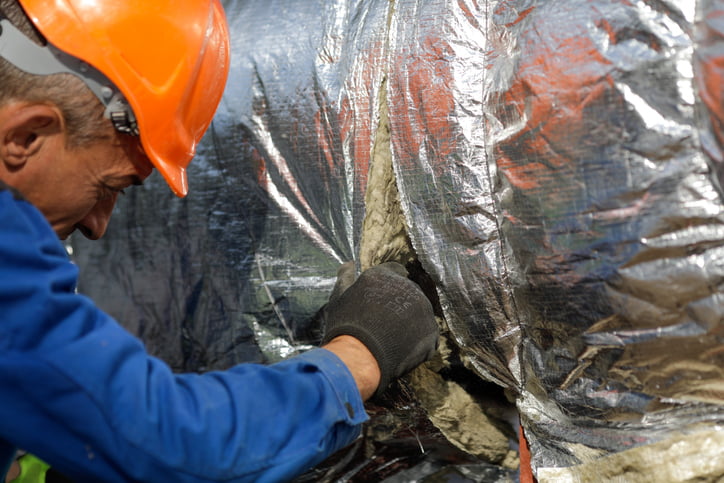Achieving year-round comfort in your home is essential, but fluctuating temperatures can drive up energy bills. Glass-fiber insulation offers a cost-effective solution to improve your home’s comfort and energy efficiency. This comprehensive guide will explore the composition of glass-fibre insulation, explore its numerous advantages, and help you decide if it’s the right choice for your needs.
Table of Contents:
- What is Glass-fiber Insulation?
- Understanding the Composition
- Advantages of Glass-Fiber Insulation
- Conclusion
What is Glass-Fiber Insulation?
Glass-fiber insulation, also known as fiberglass insulation, is a versatile and widely used material in construction for thermal insulation. It consists of extremely fine glass fibers, usually made from recycled glass materials, that are densely packed together to create a barrier against heat transfer. These fibers are typically bound together with resins or other binding agents to form flexible mats, rolls, or batts that can be easily installed in various building structures.
Understanding the Composition
Glass Fibers
Glass-fiber insulation is primarily composed of thin strands of glass, made from recycled materials through a melting and spinning process. These fibers trap air pockets, which significantly reduces heat transfer, providing thermal insulation for your home.
Binding Agents
Binding agents, like resins or glues, hold the glass fibers together. This ensures the structural integrity and overall durability of the insulation material.
Additives
Optional additives, such as fire retardants or moisture-resistant agents, can be included to enhance specific properties of the insulation. These can improve fire resistance or moisture protection depending on the application.
Simple Composition
Despite its various components, glass-fiber insulation remains a straightforward material. It primarily consists of recycled glass fibers bound together with adhesive agents, sometimes with added enhancements for specific needs.
Advantages of Glass-Fibre Insulation
Thermal Efficiency
Glass-fiber insulation is highly valued for its exceptional ability to insulate. By effectively trapping air and reducing heat transfer through walls, ceilings, and floors, it helps maintain consistent indoor temperatures year-round.
During colder months, glass-fiber insulation acts as a barrier, preventing heat from escaping the building, which reduces the need for excessive heating. Conversely, in warmer climates, it helps keep the interior cool by blocking heat transfer from outside. This thermal insulation translates to improved energy efficiency and lower heating and cooling costs for buildings insulated with glass fiber.
Fire Resistance
One of the significant advantages of glass-fiber insulation is its inherent resistance to fire. Unlike some other insulation materials, such as foam insulation, glass fiber is non-combustible. This means it won’t contribute to the spread of fire and can help contain flames within a confined area, providing valuable time for occupants to evacuate safely and for firefighters to arrive. Additionally, glass-fiber insulation doesn’t release toxic gasses when exposed to fire, further enhancing its safety features.
Affordability
Compared to many other insulation materials on the market, glass-fiber insulation is known for being budget-friendly. Its relatively low cost makes it an attractive option for builders, contractors, and homeowners looking to improve energy efficiency and thermal comfort in their properties without straining their wallets. Despite its affordability, glass-fiber insulation doesn’t compromise on performance, offering excellent thermal insulation properties and fire resistance.
Versatility
Another advantage of glass-fiber insulation is its versatility. It can be easily installed in various construction applications, including walls, ceilings, floors, and attics. Glass-fiber insulation comes in different forms, such as batts, rolls, or loose-fill insulation, making it suitable for both new construction projects and retrofitting existing buildings. This flexibility and ease of installation allow for seamless integration into different building designs and structures.
Durability
Glass-fiber insulation is renowned for its durability and long lifespan. When properly installed and maintained, it can last for many years without significant performance degradation. Unlike some organic insulation materials, glass fiber is not prone to rotting, mold growth, or pest infestations, ensuring long-term reliability and effectiveness. This durability makes glass-fiber insulation a cost-effective investment for property owners, as it reduces the need for frequent replacements or repairs.
Environmental Sustainability
Glass-fiber insulation offers some degree of environmental sustainability. It’s often manufactured from recycled glass materials, reducing the demand for virgin materials and minimizing waste. Additionally, glass-fiber insulation can be recycled at the end of its useful life, further reducing its environmental impact and promoting sustainability. By choosing glass-fiber insulation, builders and homeowners can contribute to conservation efforts and reduce their carbon footprint.
Conclusion
In conclusion, glass-fiber insulation offers a compelling combination of affordability, performance, and environmental benefits. If you’re looking for a cost-effective way to improve your home’s comfort and energy efficiency, glass-fiber insulation is a perfect solution. For professional advice on selecting and installing the right insulation for your needs, consider contacting Ener-Spray.
